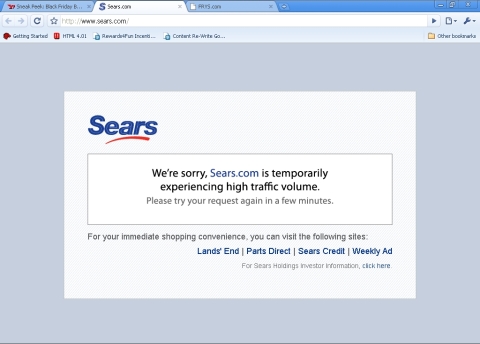Sears’ Black Friday Boo-Boo Prevention Plan
For those of you that haven’t heard, Sears had a bit of a problem during one of the busiest shopping days of the year. I personally found out about it because I was actually planning on buying something from their online store. I didn’t feel like being shot at or trampled to death in the mob of shoppers, so I jumped online where I do most of my shopping. Anyway, this is what I saw.

Not exactly the site you want to be showing your customers. How much money they lost because of this is beyond me, but oh well, I don’t own Sears the company or any of Sears’ stock…so I’m golden. ![]()
There’s been a couple of posts about this already. There was a small tidbit on Valleywag and Marketing Shift, but nothing in depth. I personally wanted to put together a piece that would help Sears and the many other large corporations who’ll probably have the same exact problem in years to come, to actually make moves in preventing it from happening to begin with. I know it’s a lot to expect from these big wigs, but it might help the smaller shops that are a little more agile and can move quicker at getting things done.
So, I’ll begin by listing some consequences of neglecting to prepare your servers for high traffic volumes:
- Loss of MUCHO DINERO!!! That’s an obvious one.
- Possible caching of 404 error page in search engines. Not so obvious.
- Loss of reputation. Someone like myself might cut Sears a little slack, because I know that these things happen, but that 21-year old Digg power user who’s pissed cuz he couldn’t buy his Nintendo Wii is going to flame the sh*t out of you…everywhere!
- Loss of job(s). Managers, IT guys and Web guys…you’re all fired!!
I think that about covers it. Now let’s see how we save ourselves from all the madness.
Communication
It seriously only takes one person within the company who has even a tiny amount of influence and courage to get everyone on the same page, which leads me to my next point.
Leadership
Somebody needs to step up to the plate to make this a priority. Don’t be afraid, open your mouth, keep telling whomever you can that the company needs to be more prepared for handling heavy traffic during the holidays. Constant nagging has a way of getting others to move out of their complacency, just so they can get that guy to shut up. Chances are “that guy” will be the president of the company someday.
Update Networking Hardware
Hardware issues probably won’t even be touched until effective communication has been established by a viable leader within the company. After that, I’m sure the IT department knows what needs to be upgraded. Get it done!!
Monitoring service
If I was “that guy,” I would find all the email addresses of the most influential people within the company (maybe even the CEO), and I’d dump them into a website uptime monitoring service. That way when Bill Crowley is watching the New England Patriots play football on black friday, he can conveniently receive a text message that Sears.com is losing millions and millions of dollars. This is just a guess, but the problem might get some more attention.
Want More From Your Website? Ask The Three Wise Men
I couldn’t resist the analogy. ![]()
Traffic, analytics, and conversions; the three proverbial wise men of internet marketing are making their presence known in a big way. Learn how to implement them properly, and your website will be ahead of the pack. Neglect one, and you could be wasting your time chasing the other two.
SEO, SEO, SEO! That’s all I’ve been hearing for the last few years. Everyone is starting to “get it”, and everyone is jumping on this SEO bandwagon. I see new search marketing blogs and consulting services popping up by the hundreds, if not thousands, on a monthly basis. Businesses that had no idea what “title tags” and “linkbait” meant just a couple years ago are now throwing those phrases around without problem. Ladies and gentlemen, our first wise man has arrived.
For someone who is in the business of making sites “better”, this is a great thing. I’m finally seeing an aspect of online marketing becoming popular. The general public has seen a proven method that they can use to bring more traffic to their site, which in turn results in more exposure. But, here’s my question to you: “Now that you have all that traffic, what are you gonna do with it?”
Enter the second wise man, website analytics. Up until now, SEO has gotten so much of the attention, that most businesses haven’t even had the chance to look at all of that traffic data to see if and how it’s working. Is all of that traffic that you paid so much for, actually helping your site? It’s a question that’s going to be asked more frequently, as we see our industry grow. I recently read a blog post over at Search Engine Watch about why web analytics is such a neglected practice. I just don’t think that anybody is thinking that far ahead yet, which opens up a big opportunity for all you forward thinkers. Web analytics will tell you if your search marketing efforts are paying off, and where you should allocate more of your budget. It may be complicated, but that’s what outside firms are for. Get some professionals to implement a nice analytics program into your site, and see the payoffs in cash.
Speaking of cash, let’s look at our third wise man; conversion optimization. Another under-utilized and under-appreciated segment of online marketing. Conversion analysis and landing page optimization are essentially a way for you to turn that hard earned traffic directly into money. The higher your conversion rate, the more sign-ups, transactions, or members your site will have. Just by focusing on increasing your conversions by a small percentage, you can increase your profit margin dramatically. Yet, I still see so many companies neglecting or downright refusing to invest in this strategy. It’s a shame, but I’m certain that most will eventually catch on. Just make sure that you’re not part of the “late majority or laggards” to pick this up.
I think that majority adoption of the three wise men are going to come in waves. The first wave we’re beginning to see with SEO, and the others will follow. It’s always good to be ahead of the curve though.
In a future post, I’ll break all three segments down and show you how you can include them in your overall web strategy.
Internet Strategy; The MMA of Online Marketing

Most of you already know that I am a huge Mixed Martial Arts fan. If you don’t know what MMA is, then check out Sherdog.com. There’s a ton of cool stuff there about the sport.
Now, in order for one to be a truly great MMA fighter, one must be versed in a variety of different skill sets. You not only have to be great at fighting on your feet, but on the ground and everywhere in between as well. Usually the best fighters are the ones that are the most well-rounded in every art form. Sure, there are some guys who are so incredibly talented in one art that they can always rely on their specialty to carry them along. But, if they really wish to be a challenge to their opponent, they will make the effort to master, or at least learn, another discipline.
I think as online business owners and web marketers, we must have that same mentality. Specializing in one area is still a sure fire way to succeed online, but it’s not the only way. Things are changing, and the company or individual who can take SEO, PPC, Analytics, Usability, etc… and throw it all together as part of a strategic plan, is going to be very hard to compete with.
The other day I was reading Website Magazine and in the back, there was a small article about the Internet Strategy Forum. In a nutshell, the ISF provides a venue for a certain type of professional that is emerging in today’s market; The Internet Strategist. These individuals are the ones formulating and putting into action the plans behind their company’s online presence.
In a fight, the right game plan can mean the difference between a win and a loss. The same goes for websites, so it’s no surprise that many businesses are realizing the need for these types of specialists. You can think of them much like the trainers in MMA. If the fighter is the one doing the “dirty” work, then the trainer is the one who put together the whole pre-fight strategy.
Mixed Martial Arts has seen tremendous growth in the past few years, and with that popularity we’ve seen a new breed of fighter coming into the picture. These are the guys who know how dangerous they can be if only they make the effort to learn and use multiple disciplines instead of just one. The same exact thing is happening on the web today.
As the industry matures, we’ll see more and more well-rounded fighters (marketers) graduate to trainers (internet strategists), and the cycle will repeat itself becoming much more efficient and effective.
There are some exciting times ahead both in the octagon and on the WWW.
How A Dead Man Helped Me Double My Adwords Conversions
We’ve all heard of Pareto’s Principle; more commonly known as the 80/20 rule. I remember reading about him in high school, but it wasn’t until a couple months ago that I decided put him to the test to see if old Vilfredo actually knew what he was talking about. Well, I have to say that I was quite impressed.
I decided to use my Adwords account as the test subject for this experiment.
For those of you who aren’t familiar with day-parting, I’ll give you a quick breakdown. In a nutshell, it’s a way of choosing what day and what time during that day you want your ad creatives to be displayed to potential viewers. Google allows you the option of “shutting-off” your ads during certain days and times that you don’t think you’re visitors will be actively searching for your products or service. This gives you the opportunity to maximize your ROI, by spending more of your budget on time slots that you’ve determined to be most effective.
Now with that said, you’re probably wondering how Pareto’s Principle plays into all of this.
Well, this is what I did:
1. I looked at all of the conversions that I had received for the past three months, and started looking for a pattern.
2. I asked myself; “Which 20% of days within the 7 day week, are bringing me 80% of my conversions?” But I didn’t stop there…
3. I then asked myself; “Which 20% of hours within the 24 hour day, are bringing me 80% of my conversions?”
When it was all over, I was amazed. In the past three months, most of my conversions were being generated between 8am-10am on Monday’s and Wednesday’s. I was able to cut out all of those other “wasted” clicks, and reallocate my budget to the most cost effective 20%. I ended up raising my conversion rate from 2% to 4%, and reduced my cost per conversion by 25%.
I haven’t tried this on the keyword level just yet, but you can bet that I’ll be doing that very very soon.


